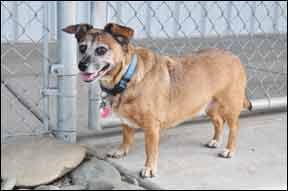It’s a very tempting concept – that a perfect food for every dog exists out there, somewhere. It must be tempting, because the pet food manufacturers keep increasing the number of products they formulate and market toward the owners of dogs of a progressively narrow description. Seriously – there are foods labeled for large breed seniors, and indoor toy puppies. There are foods that are supposedly just right for Spaniels, for goodness’ sakes!

288
Decades ago, there was just dog food; eventually, versions of commercial foods for puppies were introduced to the market with great success – perhaps because of the introduction of commercial baby foods in the same historical period! Today we are supposed to choose among foods for dogs who are young, old, active, sedentary, fat, thin, big, and small; there are foods supposedly formulated especially for dogs who live indoors! And this is not even mentioning the plethora of products (prescription or over-the-counter) that are supposed to address the problems a dog might have with his skin, coat, digestion, urinary tract, or joints.
Here’s the thing: Much of what you’re paying for with most – but not all! – of these foods is marketing. Some specialty foods are only marginally different from each company’s regular adult dog food; others deviate from the regular formula significantly, but without consistency across the specialty. For example, some pet food companies formulate their “senior” diets with higher protein levels than their “adult” dog foods; some formulate their senior foods with protein levels that are dramatically lower than their adult foods.
How can you tell whether your dog’s specialty food is really all that special? As always, you have to look past the marketing and disregard the illustrations on the label; it’s the ingredients and the guaranteed analysis of the food you need to examine. And in the long run, it’s the food’s actual performance in your dog that counts; if your dog doesn’t look and feel like a million bucks, you should probably change foods.
Protein and Fat
The principal factors that are manipulated to formulate foods targeted toward the primary dog food categories – puppies, adults, and seniors – are protein and fat. One thing is certain: puppies need more protein and fat in their diets than adult dogs. After that fact, things get a bit contentious.
The micronutrient (vitamin and mineral) needs of puppies, adults, and senior dogs are not very different, except that puppies also need more calcium and phosphorus than adult dogs.
Puppy vs. Adult Food
In this country, the commonly accepted set of nutritional standards for the production of commercial pet food are known as the AAFCO Nutrient Profiles. AAFCO is the Association of American Feed Control Officials, an advisory committee comprised of the state feed control officials (the only voting members) as well as interested representatives from the pet food industry – ingredient suppliers, manufacturers, food laboratories, and so on. Sub-committees study particular subjects of interest, such as the nutrient profiles for dogs and cats, and make suggestions for changes when new studies suggest change may be beneficial; this happens only after a great deal of data supports the change, and usually, after a lot of debate.
The AAFCO Dog Food Nutrient Profiles list minimum amounts (and a few maximum amounts) of all the nutrients that are currently known to be required by dogs; there is a column of numbers for adult dog maintenance, and one for “growth and reproduction,” that is, puppies and pregnant or nursing females.
The minimum amount of protein and fat suggested in these profiles for adult dog maintenance is 16.2 percent and 4.5 percent respectively. The minimum percentage for protein and fat for puppies (“growth and reproduction”) is 19.8 percent and 7.2 percent.
(Note: All percentages in this article are expressed “as fed.” The AAFCO Dog Food Nutrient Profiles list the numbers in what’s called the “dry matter” form, that is, with the water in the food removed. We’ve converted the numbers so they are comparable to the number on dog food labels, which are “as fed,” or including the moisture in the food.

288
If the food label says it’s a puppy food, it’s for sure using the “growth and reproduction” values. If the label says it’s for adult dogs, it’s probably using the AAFCO values for adult dog maintenance.
Look for the AAFCO statement, somewhere in tiny print on the bag. It could say either something like, “Food X provides complete and balanced nutrition for maintenance of adult dogs,” in which case it’s been formulated with the “adult maintenance” values. However, it might say something like, “Food X provides complete and balanced nutrition for dogs of all life stages,” in which case, it’s using the “growth and reproduction” values.
This is why you have to look closely at the label; many foods that are labeled as for “adult” dogs are relatively low in protein and fat. Foods that are labeled as being for dogs in “all life stages” will almost always contain higher levels of protein and fat.
Puppies Shouldn’t Have “Too Much”
You may have noticed that the word “maximum” hasn’t come up. The AAFCO nutrient profiles list maximum values for only calcium and phosphorus (too much can adversely affect the development of the puppy’s skeleton, with life-long consequences); and the nutrients that can cause toxicity at excessive levels, such as the fat-soluble vitamins A, D, and E; and the minerals magnesium, iron, zinc, iodine, selenium, copper.
That doesn’t mean that more of everything else is better. While top-quality dog foods tend to have higher levels of protein and/or fat than their low-cost, low-quality counterparts, puppies shouldn’t ever be fed in such a way that they become fat or experience abnormally fast growth spurts. Despite our cultural fondness for roly-poly puppies, healthy puppies are lean and grow at a consistent, slow rate. Ideally, owners weigh their puppies frequently, and decrease either the pup’s rations or his total caloric intake if he’s getting too chubby or growing too tall too fast.
Senior and Weight Control Diets
Poor old dogs! There is perhaps more variation in the amount of macronutrients in senior diets than in any other category of dog food. Keep in mind that there are no commonly accepted nutrient levels for anything other than adult maintenance and “growth and reproduction” –there are no AAFCO values for old dogs. Each pet food manufacturer has its own ideas about what senior dogs need. In fact, it turns out that most people have different ideas about what old dogs need.
A fascinating study was published recently in the International Journal of Applied Research in Veterinary Medicine demonstrating that the majority of people surveyed (84.5% of more than 1,300 respondents) believe that senior dogs have different nutritional needs than adult dogs. Further, most respondents indicated that senior dog diets should contain reduced levels of calories, protein, fat, and sodium, and contain increased amounts of fiber. Talk about projection!
The fact is, due to any number of factors (including decreased appetite, changes in their ability to taste or smell, difficulty chewing, and/or underlying disease), many dogs lose weight (specifically, the nice lean muscle mass that they need for getting around) in their “golden” years. Many studies have shown that senior dogs actually have higher protein requirements than younger dogs; if you put a lean senior dog on a low-protein, low-fat diet, you are asking for severe weight loss and infirmity.
But many pet food makers seem to assume that all old dogs get fat, and frequently, there is little or no difference between a company’s “senior diets” and their “weight management” diets. That’s one of the reasons that so many senior diets contain less fat than adult foods. (Remember, each gram of fat – any kind of fat – contains about 9 calories. A gram of any kind of protein or any kind of carbohydrate contains about 4 calories.)

288
Following the same “fat old dog” logic, some senior dog foods also contain high levels of fiber, in an attempt to “fill up” those “fat old dog.” Unfortunately, the more (inexpensive) fiber in a formula, the less room there is for more nutritious –and equally caloric – protein. Ugh! Why would they do that? Both because it’s more profitable, and because they can; dog owners who buy the least expensive foods won’t necessarily notice that their “old” dogs are prematurely aging due to poor nutrition.
However, not all senior foods are like this; some companies formulate their products with moderate levels of protein and fat. How can you tell? You have to look at the label! Look at the amounts of protein and fat in the food; you know the minimum levels for adult dogs (16.2 and 4.5 percent, respectively). You’d want to see a protein level well above the minimum, and a fat level that is at least a bit above the minimum – more for a thin dog, or one whose coat and skin are dry.
The same goes for “weight control” diets. Most contain the absolute minimum of fat (and often low levels of protein, too) and lots of fiber. Again, since protein and carbs contain the same number of calories per gram, we’d rather see a chubby dog eating a diet containing a lower-fat, diet with a moderate amount of nutritious (and biologically appropriate) protein, than a lower-fat, low-protein, diet that necessarily contains a high amount of less-nutritious carbs.
As always, look also for high-quality sources of protein high on the ingredient list, such as chicken, chicken meal, pork, pork meal, etc;, rather than chicken by-product meal or corn.
The Starting Point
It’s the most common question we receive: What should I feed my dog? What people often forget when they ask us to tell them which food they should feed their dogs is that their dogs are already eating something. How does the dog look and feel now? If he looks and feels great, you may well be doing just fine with your selections! But if he’s thin and run down (or fat and lethargic); if his coat is dull and/or his skin is dry; if he’s often ill (or in an ugly “mood”), take a look at the protein and fat levels in his food – and look for a food with more. More protein or more fat? Yes! How much more? Well, it depends on how much you are already feeding him, and on the quality of the proteins and fats. (For more about recognizing the hallmarks of quality foods, please see “Choices, Choices,” our review of dry dog foods, in the February 2011 issue.)
If it turns out that the food you have been feeding your dog contains close to the minimum amounts of either protein or fat, consider looking for a food that boosts those numbers by at least 5 or even 10 percent. See how he responds. If he does better, consider boosting those levels a bit with an even better product with the next bag, until he seems to attain a healthy weight and condition.
If the food is a high-quality product (it meets Whole Dod Journal’s dog food selection criteria, as described annually in the February issue) and contains relatively high protein and fat levels and your dog is still too-thin or suffers from any sort of skin or coat problem or low energy, I’d first schedule a visit to the vet for a checkup, and then try another high-quality food, perhaps one with different protein, fat, and carbohydrate sources.
No Holy Grail
Please don’t forget that there is no single right and best food for your dog, or any dog. In fact, it’s a good idea to change your dog’s food at least a few times a year; no dog should be fed the same diet for months and years on end. For one thing, it’s a perfect way to set up your dog for developing an allergy to the ingredients in that food; most commonly, dogs with food allergies develop those allergies after long-term, continuous exposure to the ingredients in their daily food.
Also, nobody’s perfect. Personally, we don’t trust any one product to provide the precise amount of every nutrient our dogs receive – every vitamin and every mineral, in the exact same, unchanging amounts and proportions – for years on end? If this was the best way to nourish an animal, why do human nutrition experts recommend a varied diet?
Next month, we’ll examine the dog food diets designed for dogs of certain breeds and sizes, as well as the so-called therapeutic diets and their close counterparts, “prescription” diets.
Nancy Kerns is the Editor of WDJ. Her mixed-breed dog, Otto, eats a different kind of food at the end of every bag.






